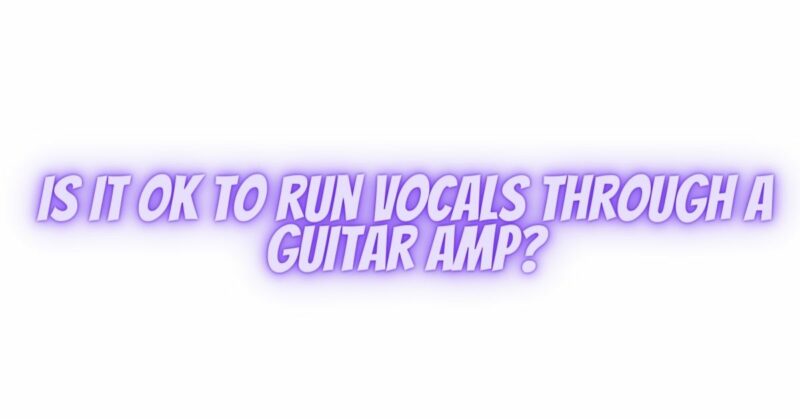Musicians and audio enthusiasts often explore unconventional ways to shape and manipulate sound. One question that occasionally arises is whether it’s acceptable to run vocals through a guitar amplifier. In this article, we’ll examine the possibilities, advantages, disadvantages, and potential risks of using a guitar amp for vocal amplification.
The Guitar Amp’s Function
Before we discuss using a guitar amp for vocals, it’s essential to understand the primary function of a guitar amplifier. Guitar amps are designed to amplify the electrical signal generated by an electric guitar’s pickups. These amps shape the guitar’s tone, add coloration, and project it through a speaker. They are optimized for the specific frequency range and tonal characteristics of electric guitars.
Running Vocals Through a Guitar Amp
Pros:
- Creative Sound Shaping: Using a guitar amp for vocals can introduce unique tonal qualities to your voice. The amp’s built-in tone controls, such as bass, midrange, and treble knobs, allow you to experiment with different EQ settings to achieve distinctive vocal sounds.
- Distortion and Effects: Guitar amps often come with built-in distortion and effects like reverb and tremolo. These effects can add texture and character to your vocals, creating interesting and creative sonic textures.
- Portability: In certain situations where a dedicated PA system or vocal amplifier is not available, using a guitar amp can be a practical solution for amplifying vocals, especially in smaller venues or home recording setups.
Cons:
- Impedance Mismatch: Most microphones used for vocals have low-impedance (low-Z) outputs, while guitar amps are designed for high-impedance (high-Z) inputs. Plugging a low-Z microphone directly into a high-Z guitar amp input can result in poor impedance matching, potentially leading to sound quality issues.
- Limited Sound Control: Guitar amps may not provide the precise control and equalization needed for vocals. They are optimized for guitars and may not offer the versatility required for vocal amplification.
- Feedback: Guitar amps are not designed to handle the feedback-prone nature of microphones used for vocals. Placing a microphone too close to the amp’s speaker can result in feedback issues, making it challenging to control the sound.
- Risk of Damage: Running vocals through a guitar amp can potentially damage the amplifier’s circuitry, especially if the microphone produces a stronger signal than the amp can handle.
Alternative Solutions
If you want to amplify vocals more effectively and safely, consider these alternative solutions:
- PA System: The most appropriate solution for vocal amplification is to use a dedicated PA (Public Address) system. PA systems are designed to handle microphones and provide preamplification, equalization, and power amplification specifically tailored for vocals.
- Vocal Amplifier: Vocal amplifiers are designed explicitly for amplifying vocals. They offer better control over EQ settings and are equipped to handle the unique characteristics of vocal microphones.
- Powered Speakers: Powered speakers (active speakers) are versatile and can accept microphone inputs directly. They offer a straightforward and reliable way to amplify vocals without the limitations of using a guitar amp.
- Mixer: Using a mixer allows you to connect both microphones and instruments and provides control over their respective levels and equalization. You can then route the mixed signal to an appropriate amplifier or powered speaker for projection.
Conclusion
While it is technically possible to run vocals through a guitar amp, it is not the most suitable or recommended option for vocal amplification. Guitar amps are designed for electric guitars and may not provide the necessary features, sound control, or impedance matching required for vocals. To achieve the best results when amplifying vocals, invest in dedicated vocal amplification equipment, such as a PA system, vocal amplifier, or powered speakers. These options will ensure clear and reliable vocal projection, whether you’re performing live, recording, or using microphones for various audio applications.


